In previous articles, we talked about the two types of cell division, mitosis, and meiosis. We also described the differences between the terms chromatin, chromosome, and sister chromatid. However, if at this point someone asked you to find the number of chromosomes, chromatids, DNA molecules, and others, would you still have difficulty answering? If your answer is yes, you are not alone. The various phases of the cell cycle can be confusing, but the following paragraphs will help you tell these events apart and give the correct answer.
To make things easier, we will use a hypothetical organism as an example. Our organism’s somatic cells contain 4 chromosomes. Therefore, the diploid number is 4, while the haploid number is 2, which shows the number of chromosomes in gametes.
Mitosis
We will begin with the events of mitosis. During the S phase of interphase, DNA undergoes replication. That means every chromosome consists of two sister chromatids bound to the centromere. Since there are 4 chromosomes, chromatids will be double that number (8). The same situation continues to apply to prophase and metaphase when the 4 chromosomes line up to the equator.
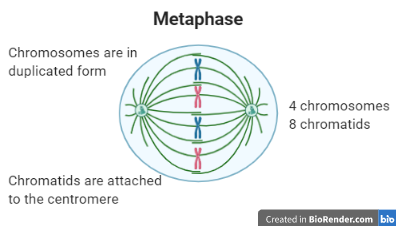
Next, the sister chromatids are pulled apart during anaphase. Since they are separated, each chromatid at this point is considered an individual chromosome. That means we now have 8 chromosomes or otherwise 8 chromatids.
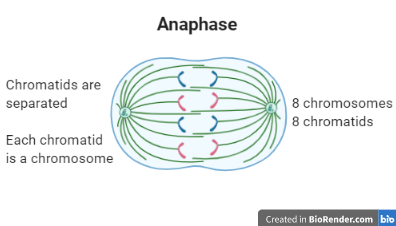
The same numbers apply in telophase until the cell splits in two. As the division ends, each of the two cells has half the genetic information, 4 chromosomes, and 4 chromatids. These are diploid cells that are ready to start their own cell cycles.
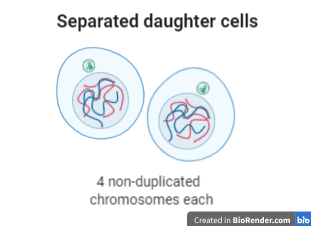
Using what we learned from the hypothetical case, we can guess the respective numbers in humans. Somatic cells possess 46 chromosomes. When DNA is copied, there will be 96 chromatids. And if we follow the same train of thought as above, we will end up with the information that’s given in the following table.

Meiosis
Now let’s take a look at the events of meiosis. Using the hypothetical organism again, after DNA replication, the cell enters prophase I having 4 chromosomes and 8 chromatids. In metaphase I, the chromosomes are aligned to the equator in pairs of homologs, so the numbers do not change.
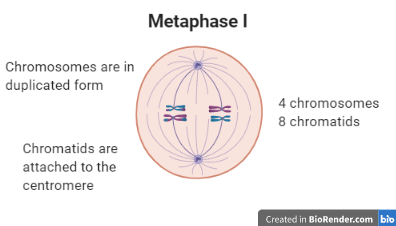
In anaphase I, the homologous chromosomes are pulled towards opposite poles. However, the chromatids remain linked to the centromere. Since chromatids are not separated, the number of chromosomes does not change. The cell enters telophase I having 4 chromosomes and 8 chromatids.
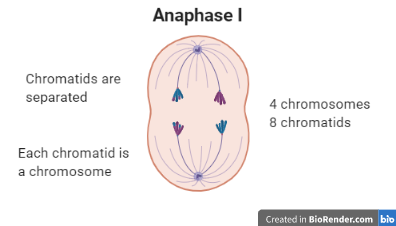
As the cell splits in two, it provides each daughter cell with half of the genetic material. So, each daughter cell contains 2 duplicated chromosomes and 4 chromatids in total.
With the initiation of meiosis II, each cell has 2 chromosomes and 4 chromatids. These numbers remain the same until the end of metaphase II.
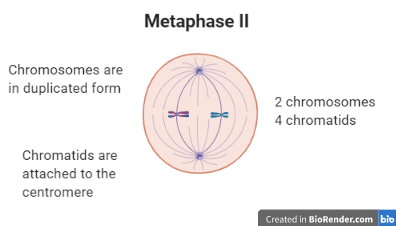
In anaphase II, the sister chromatids of each chromosome are separated and pulled towards opposite poles. That happens for the first time in the meiotic process. As a result, the number of chromosomes temporarily doubles. In anaphase II and telophase II, there are 4 chromosomes and 4 chromatids.
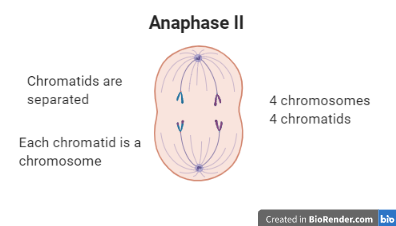
At the end of meiosis II, each of the four daughter cells acquires half of the genetic information in the form of 2 chromosomes or 2 chromatids.
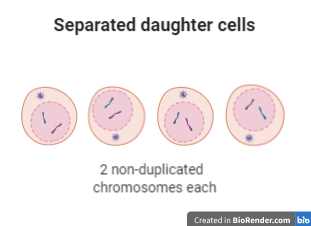
Similarly, human cells start the meiotic process with 46 duplicated chromosomes (96 chromatids) and end the division with 23 chromosomes in haploid cells. The numbers of chromosomes and chromatids in the rest of the intermediate phases appear in the table below.
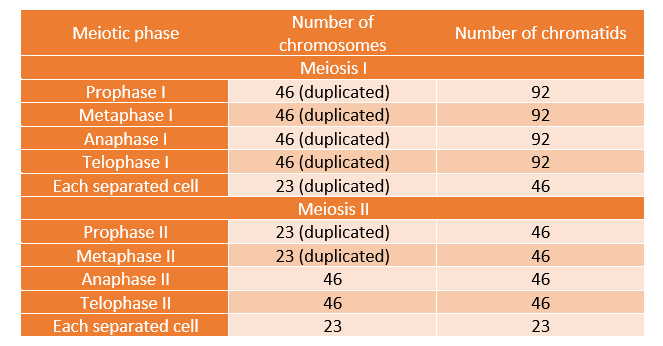
DNA numbers in human cells
In the previous paragraphs, we made a distinction between chromosomes and chromatids. Let’s discuss now which version of DNA is present in different phases of the human cell cycle as well as the amount of genetic information.
Before DNA replication in interphase, when we refer to chromosomes, we use the term chromatin fiber since the DNA has not yet started the condensation process. After DNA replication, on the other hand, chromosomes appear in the form of two sister chromatids that are linked to the centromere.
At this stage, we have to discuss the term DNA molecule. Before replication, each chromosome is considered one DNA molecule. Since a human somatic cell contains 46 chromosomes, there are 46 DNA molecules in total. After DNA replication, each chromosome consists of two chromatids, with each chromatid comprising a DNA molecule. As a result, a cell consists of 96 chromatids or 96 DNA molecules. This number also applies to the mitotic phases that follow until the splitting of the cell takes place.
When a daughter cell emerges and is ready to start its cell cycle, it consists of 46 chromosomes in the form of 46 chromatin fibers or 46 DNA molecules. If we managed to count every single base pair in a somatic cell, we would find about 6 billion base pairs. That is the case before the S phase. After DNA has made a copy of itself, the number of base pairs will be double (12 billion base pairs). Gametes, instead contain half the information of the somatic cells, so they consist of 3 billion base pairs.
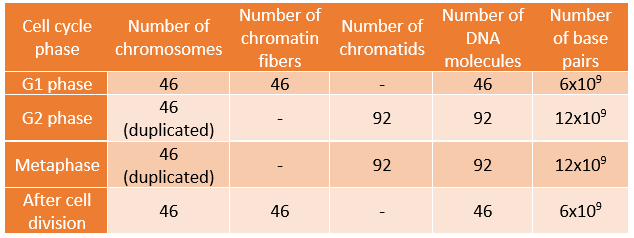
For more information, you can watch these two interesting videos explaining the changes in numbers:
